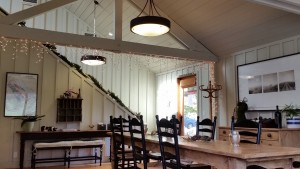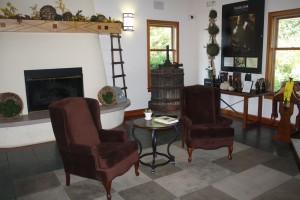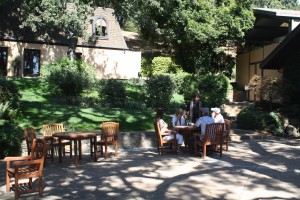This is an unusual “Places to Visit” article, because you can’t visit the places described here. They’re gone, vanished into corporate policy, Napafication, wine economics or just the passage of time. We’re talking about wineries that we have loved in the past that are no longer there. These musings were occasioned by a recent visit to Joseph Phelps’ Freestone winery in Sonoma county. Phelps is one of the best known Napa Valley wineries and they added a tasting room way out towards the Sonoma Coast when they bought vineyards in the area in the late 1990’s. It has been open since 2007 and as of December 31, 2016 it will be closed.

Joseph Phelps’ Freestone Visitors Center
The tasting room had a gracious farmhouse feel to it and we hope that someone else decides to share their wines there. Even if someone does, it won’t be the same without those wonderful Phelps wines, which will still be available at their St. Helena winery. How sad that future wine lovers won’t be able to enjoy it the way that we did. (Actually, we’d love to buy it as a home but Phelps isn’t offering and we doubt that we could afford it.)
Not so many years ago, Michael Mondavi Family, owned by the son of the great Robert, had a winery in Carneros. It was similar to the Phelps Freestone winery in that it also gave visitors a sense that they were stopping by an old friend’s home. Sure, there was a bar and a server, but with a fireplace and some easy chairs, you felt that Mike would be dropping by any minute to offer you a glass and a welcome. Okay, this was all in the imagination but for one thing, wine tasting calls for some imagination and for another, that feeling is part of the experience.
[Today the Michael Mondavi tasting room has been replaced by that of a businessman who has turned the winery into a monument to ego and garish taste. No more need be said about the sense of loss.]
The former Michael Phelps Family tasting room
Perhaps the saddest loss was the Stag’s Leap tasting room built by the master winemaker, Warren Winiarski. Oh, you can still visit Stag’s Leap Vineyards and taste their famous wines. But Mr. Winiarski hasn’t had anything to do with them for some years now, since he sold his vineyards and winery to a conglomerate. Today, there’s a stunning stone and glass Visitors Center there, a truly modern Napa building. But there used to be a wooden building, a bit too crowded to be sure, with an inviting terrace and shady trees that told you that wine making is about farming and artistry, not just business.
The former terrace of the Stag’s Leap winery
There was that same sense in a lot of the wineries that have upgraded to meet the demands of tourism and trade. Perhaps it’s just wistfulness, but there was an immediacy to the experience when you stepped up to a plank stretched between two barrels and got a glass of wine from the fellow whose name was on the bottle. You can still experience that in Paso Robles and other out-of-the-way corners of Wine Country. But for Americans, it all started in Napa Valley and it is missed there.
There is more than simple nostalgia to these memories. Wine has a history; that’s why they give it vintage years. And wine tasting, as a voyage and as an experience, has a history as well. Our children won’t encounter a visit to Wine Country the way we did. It will be great fun for them too, but it won’t be the same fun. We have no yen to bring back the good ol’ days. They weren’t always that good; some poor wineries have been replaced by great wineries
in places that were only orchards back then. But it is important to keep the memory alive, if only to measure progress. As the economics of wine making and selling have changed the product, so it has changed the sensation one gets when going wine tasting. As wineries like Phelps Freestone and Michael Mondavi Family disappear, a bit of our lifetimes disappear with them.

